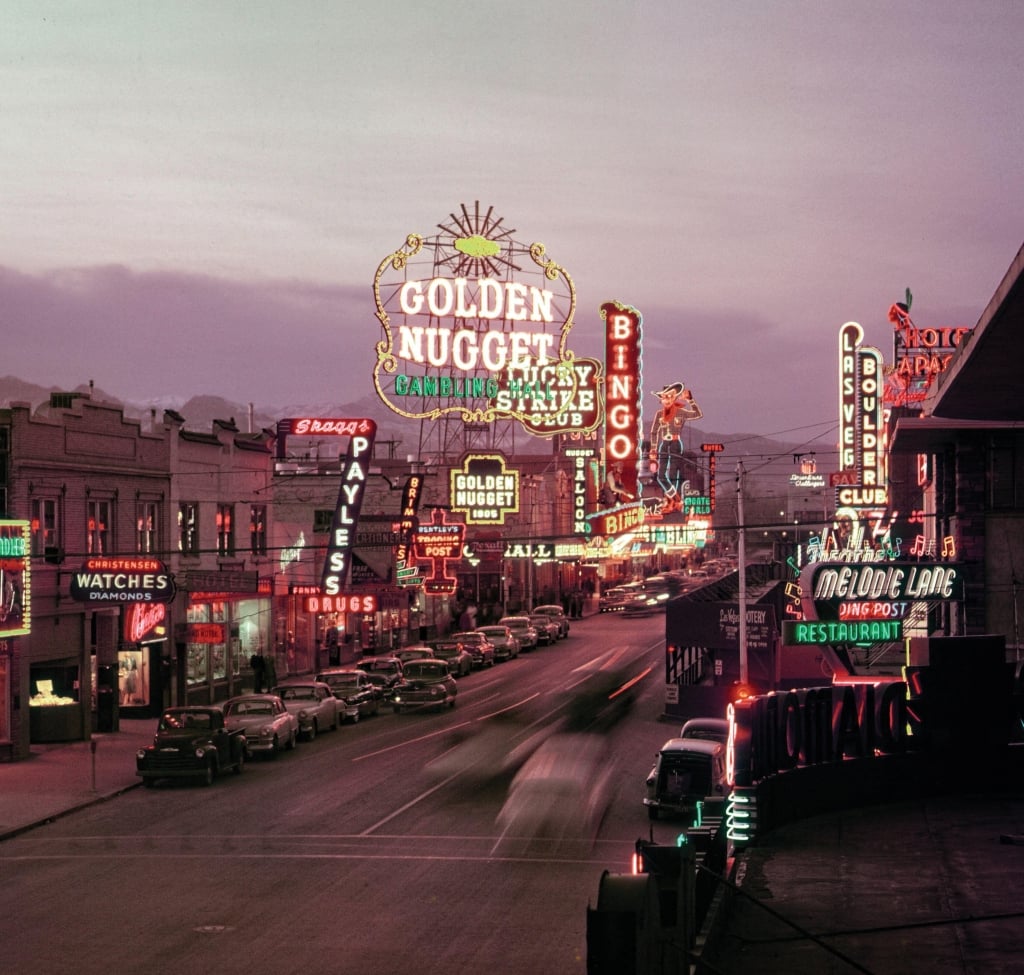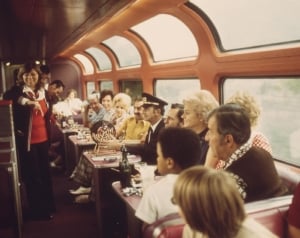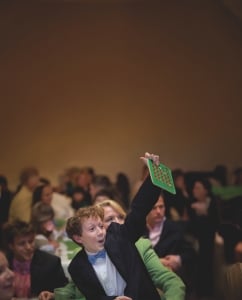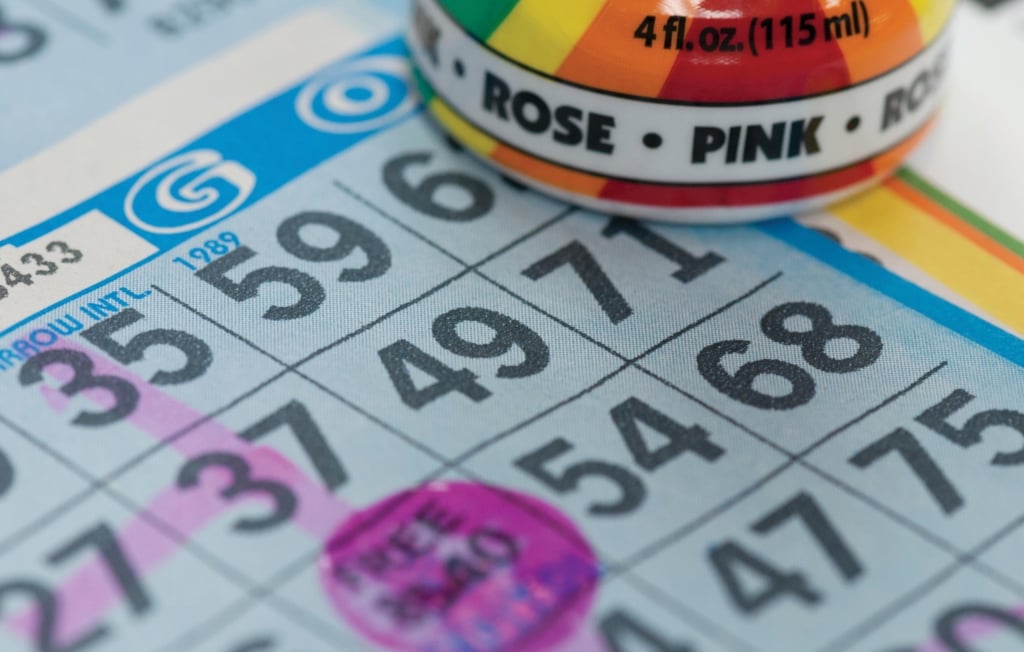A Legacy of Luck
The thrill of chance and nostalgia that keeps Bingo calling back.

A 1940s view of Fremont Street and Golden Nugget Gambling Hall in Las Vegas, Nevada.
It’s a Sunday night in Tokyo, and a crowd gathers for an adults-only bingo showdown that looks more like a DJ set than a game night. Across the globe in Naples, Italy, families huddle over tombola cards during the holidays, calling out superstitious symbols with half-whispered reverence. In London’s East End, entertainers host raucous bingo nights in glitter-drenched clubs.
It’s a global moment for a game that, not long ago, was almost seen as a relic. Its revival, however, may reveal as much about us as it does about the game itself.
ORIGINS OF CHANCE
Games that endure for centuries don’t do so by chance. Bingo’s staying power comes from its curious duality — it creates structure out of randomness, striking a balance between order and uncertainty. That tension is what has allowed it to remain relevant across cultures and generations.

Bingo aboard the lounge car of the Southwest Limited, 1974.
Bingo’s earliest ancestor is thought to be Il Gioco del Lotto d’Italia, a 16th-century Italian lottery system used to fund civic initiatives and infrastructure projects. By the 18th century, it had traveled to France, where aristocrats added game boards and tokens, turning it into a parlor pastime for the elite. Germany followed, introducing bingo-like games as educational tools for children, drilling spelling and multiplication tables through the thrill of randomized rewards.
It wasn’t until the 1920s that bingo began to resemble the game we know today, thanks to a traveling toy salesman named Edwin S. Lowe. While visiting a carnival in Georgia, Lowe stumbled upon a crowd playing “Beano” — a game where players used beans to mark numbers on cards. The story goes that one excited winner accidentally yelled “Bingo!” instead of “Beano,” and a new name was born.

1980s Saturday Night Bingo
FROM CHURCH HALLS TO CULTURAL CROSSROADS
Lowe’s version of bingo exploded across the U.S. in the 1930s, especially among churches and schools that used it as a tool for fundraising, even in states where gambling was otherwise banned. With minimal equipment and simple rules, its structure was ideal for fostering community, and it quickly became the game that bridged generations.
Across the world, variants began to take on local flavor. In the U.K., bingo parlors became social lifelines for working-class communities, peaking in popularity in the 1960s. In Mexico, lotería, a cousin to bingo played with illustrated cards, retained its folkloric art and symbolism, blending game night with cultural storytelling. In Japan, bingo merged with technology, becoming a staple of game shows and anime episodes.

Sea Island Bingo Caller
At Sea Island, bingo has long been a signature tradition — equal parts elegance and exuberance. Guests arrive dressed to the nines, gathering beneath the chandeliers of The Cloister Ballroom, where generations sit elbow to elbow, cards in hand, anticipating every call.
“For decades, bingo at Sea Island has been something of a spectacle,” says Wheeler Bryan, Sea Island Historian. “It’s not unusual to see tuxedos, cocktail dresses, even the occasional seersucker suit in the crowd. People show up early, they come ready to win and by the end of the night, there’s dancing, cheering and laughter. It’s more than a game. It’s a tradition uniquely wrapped in Sea Island charm.”
A PLACE AT THE TABLE
Today, bingo isn’t just being rebranded — it’s being reclaimed. It’s no longer just about luck or prizes; it’s about belonging. To some, that’s always been its hidden currency.
Playing for Purpose
 For guests of Sea Island, bingo is more than a lively tradition — it’s a legacy of giving. Held in The Cloister Ballroom, the event draws grandparents, children and everyone in between, all hoping to shout “Bingo!” before the final number is called. Behind the excitement, however, lies something even more meaningful.
For guests of Sea Island, bingo is more than a lively tradition — it’s a legacy of giving. Held in The Cloister Ballroom, the event draws grandparents, children and everyone in between, all hoping to shout “Bingo!” before the final number is called. Behind the excitement, however, lies something even more meaningful.
Bingo proceeds benefit the Sea Island Foundation, a nonprofit 501(c)(3) organization that donates tens of thousands of dollars each year to causes across Glynn County. From housing support and youth education to environmental stewardship, the Foundation helps strengthen the community one card at a time.
Though a few lucky players may walk away with prizes ranging from $25 to $1,000, the real reward is giving back. “It’s not just about who wins the round,” says Blake Kroll, Sea Island Cares Committee Team Member. “The more we raise through bingo, the more we can contribute directly to the people and organizations who need it most.”
For over 50 years, bingo at Sea Island has raised money through themed nights, seasonal prizes and even the occasional surprise guest caller. Over that time, while the cost of a card may have changed from $3 to $5 to $10, the result has always been something far more priceless.

According to cultural anthropologists, bingo thrives because it replicates the rhythms of communal life. Everyone shows up, everyone follows the same structure and anyone can win. It provides a predictable structure with just enough unpredictability to keep everyone engaged. It’s egalitarian. The CEO and the sixth-grader have the same shot at a full card.
There are very few cultural spaces left where intergenerational interactions happen with this kind of ease. Bingo is one of them. It’s a ritual that builds a temporary but very real sense of community: the hush before a number is called, the laughter when someone accidentally shouts “bingo” too early, the brief shared silence when only one square remains.
That sense of shared experience is exactly what Bryan believes makes the resort’s own bingo nights so enduring.
“It’s almost a form of interactive theater,” Bryan says. “Each evening is distinct, shaped by the personalities in the room, the rhythm of the numbers, the caller’s quirks, even the way the crowd reacts. It becomes this collective moment that can’t be replicated. Guests who have been coming for decades will still say, ‘Remember that night we played bingo and…’ because no two nights are ever quite the same.”
THE NEXT NUMBER
If bingo’s past is rooted in ritual, its future may be dependent on adaptation.
Digital bingo, once an afterthought in the era of mobile gaming, has quietly exploded into a multibillion-dollar industry fueled by the convenience of play-anywhere access and connection with global communities. Thousands of online platforms now offer real-time play, complete with chatrooms, avatars, loyalty points and algorithm-curated card sets. In a world of remote connection, bingo has become a digital campfire: familiar, communal and low-pressure.
It doesn’t stop at screens. Some companies are experimenting with augmented reality bingo experiences. Others are combining the game with elements of escape rooms, trivia nights and even silent discos, continuing to foster the in-person connection that bingo brings. These innovative iterations show how a decades-old pastime can be endlessly reinvented with limitless trappings, but the core remains simple — numbers, chance, connection.
“It’s a game that evolves to meet people where they are,” says Bryan. “It’s one of the few traditions that still invites us to pause, pay attention and listen for our number.”




